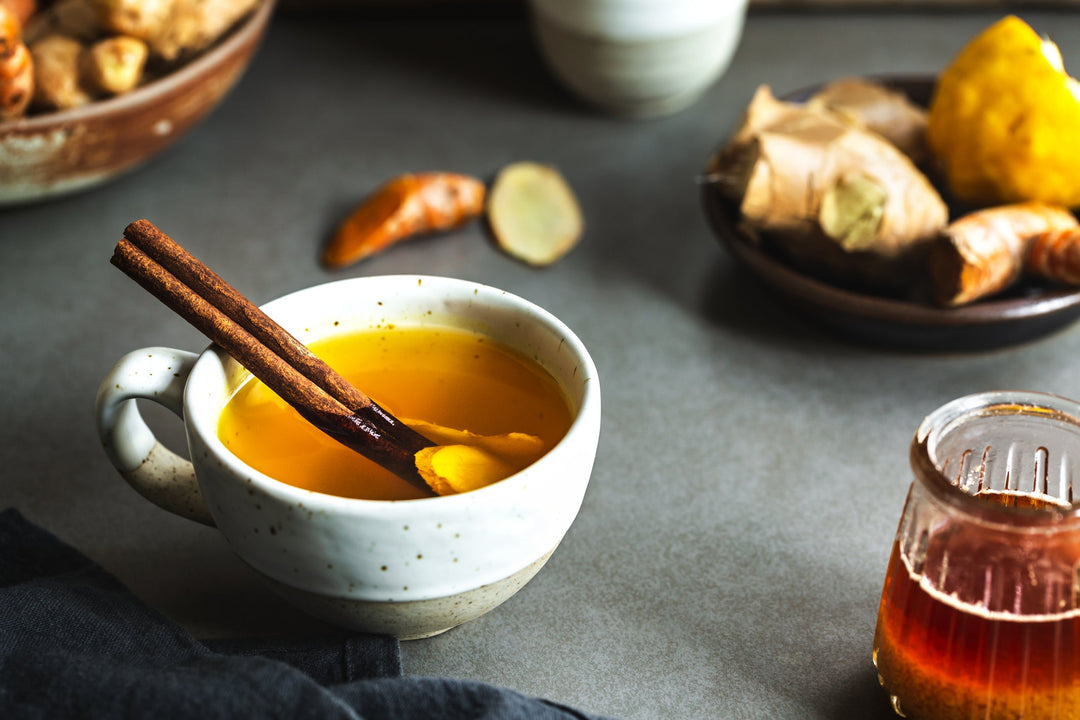What Is Turmeric Powder: The Definitive Guide
What is turmeric powder: the definitive guide
What is turmeric powder, really? From a botanical perspective, it’s a rhizomatous herbaceous perennial plant belonging to the Zingiberaceae family. But most of us aren’t botanists, so let’s look at it in laymen’s terms: turmeric is a plant native to southeast Asia and related to ginger. To create the orange-yellow powder you are most likely familiar with, part of the plant is boiled for some time and dried in a hot oven. Once dried, it is ground into a fine powder and sold for use in cooking, medicinal remedies, skin treatments and more.
Where does turmeric come from?
Turmeric has been used throughout much of Asia and the Middle East for thousands of years, most notably as the primary ingredient in most curries. Today, it’s a popular form of alternative therapy. The value of turmeric in various cultural traditions has seen some evidence for its potential benefits emerge in modern research. Leading scientific journals and publications such as Frontiers and the Journal of Nutrition have devoted their pages to analysing the benefits of turmeric on various parts of the body, as well as the benefits of curcumin, one of the main ingredients found in turmeric.
The advantages of buying raw turmeric powder
Aside from having a great flavour kick, turmeric offers numerous health benefits. Two of the most prevalent are its role in traditional western medicine as an anti-inflammatory, and as an antioxidant, both of which make it a popular choice for a huge number of health issues. The key ingredient in turmeric is curcumin, but it can be difficult for your body to properly absorb a significant amount through turmeric powder on its own. The TurmeriX formula addresses this problem with a combination of raw turmeric powder and other ingredients that help your body utilise the curcumin contained within the powder. They aid absorption, ensuring your body can take in enough curcumin to see the benefits.
Turmeric powder versus curcumin
While curcumin is an ingredient in turmeric, it gets confusing when you see products marketed with both names. If turmeric has curcumin, is that the same as a curcumin supplement? Which offers the most health benefits, turmeric or curcumin? Firstly, it’s important to identify the difference between the two. Turmeric powder is created by boiling, drying and crushing part of the plant, resulting in a blend that contains a concentration of curcumin, plus several other naturally-occurring compounds. Since curcumin is seen as the most beneficial ingredient, curcumin supplements aim to isolate and further concentrate curcumin without focusing on any of the other compounds found in turmeric. Curcumin itself is part of a group of curcuminoids and is the bioactive ingredient of turmeric.
The term ‘bioavailability’ refers to how easily a substance is absorbed by the body in order to produce a pharmacological effect. When ingested on its own, curcumin has low bioavailability, but when combined with piperine — which is abundant in black pepper — the body is able to absorb far more of this compound. That’s why we always include black pepper in our TurmeriX formulations.
Fresh turmeric versus powder
Now that you know more about turmeric, you might want to know more about fresh turmeric versus powder. Fresh turmeric rhizomes are simply the roots of the plant before they are ground to make the powder. They look much like ginger and have a lively flavour that can be used in sautéd dishes and smoothies. You can prepare them by cutting them into cubes, flat circles or matchsticks, grated with a cheese grater or juiced with a smoothie. Fresh turmeric can be found in most large supermarkets in addition to Indian and Asian grocery stores. Dried turmeric involves peeling, boiling and oven-drying the roots (known as rhizomes) before grinding them into a powder. While it may lose some freshness and pungency during the drying process, turmeric powder carries a vibrant colour and offers more diversity in use.
Curry powder versus turmeric powder
So turmeric is a major ingredient in curry — does that mean curry powder is the same as turmeric powder? What are the differences? Which is better? Once again, it’s easy to get confused when comparing the two, so here’s all you need to know about curry powder versus turmeric powder. As we know, turmeric is a plant that can be ground into a powder and combined with other ingredients to make an effective health supplement. However, we also know that it has been used in curries for thousands of years, and cooks today often simply use curry powder to make the dish.
To put it simply, curry powder is typically a blend of spices — often but not always including turmeric, chilli and cumin — ranging from mild to very spicy. While those that do contain turmeric carry some of its associated health benefits, they do differ in terms of vitamin and mineral concentration. One of the major similarities between turmeric powder and curry powder is that they both contain curcumin – curry powder due to its use of turmeric.
One key difference is iron content, with turmeric powder edging out curry powder as a better source. While a typical tablespoon of raw turmeric powder contains an average of 5.2mg of iron, a tablespoon of typical curry powder contains just 1.2mg. Maintaining a healthy iron intake aids oxygen transportation through the bloodstream, boosts immune function, and encourages cell regeneration. Turmeric also takes the cake when it comes to manganese content, offering 1.9mg per tablespoon compared to the 0.52mg found in a tablespoon of curry powder. Manganese helps wounds heal more effectively and assists the body when it comes to fighting off diseases.




